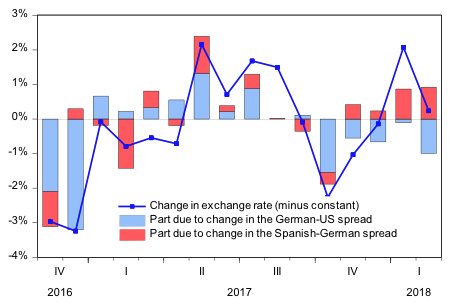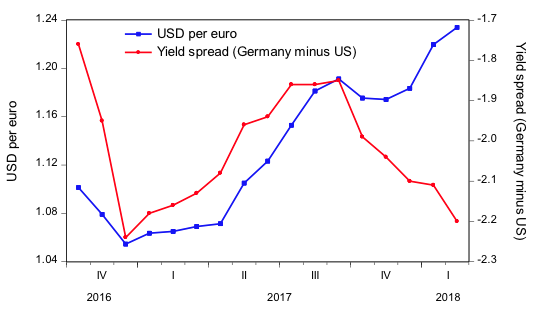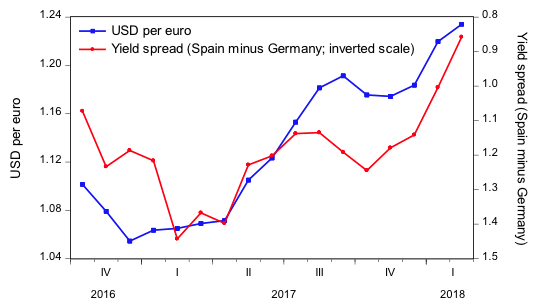Figure 3 shows the changes in the exchange rate and the parts due to changes in the German-US yield spread and the Spanish-German spread.[2] The changes in the German-US spread appear to have been the dominant driver of the exchange rate from late 2016 to October 2017. Changes in the Spanish-German yield spread also appear important, in particular in early 2018.
Figure 3 Monthly changes in the US dollar–euro rate and the parts due to changes in the German–US and Spanish–German 10-year spreads

The above analysis suggests that the depreciation of the US dollar in 2017 was due largely to long German bond yields rising relative to US yields, and to long yields in Spain (as a measure of yields in the euro are periphery) falling relative to long German yields. Since there are only 17 data points in the sample, the results may not be given much weight.
For the above analysis to be of interest, it must be that the proposed model is useful for analysis the dollar–euro rate outside of this specific sample. Re-estimating it using data since the establishment of the euro, it becomes clear that a lagged dependent variable is needed.[3] Furthermore, with 228 observations rather than 16, the explanatory power drops to 22%. However, the estimated parameters on the change of the German–US spread and the Spanish–German spread remain highly significant and, importantly, a test for a structural break at an unknown point in time does not indicate any parameter instability.
The main message from this analysis is that a large part of the fluctuations of the US dollar against the euro since the election of President Trump can be tied to movements in relative attractiveness of holding US dollars versus the euro.
ReferencesBoz, E, G Gopinath and M Plagborg-Moller (2018) “Global Trade and the dollar,” VoxEU.org, February 11.
Cheung, Y-W, M Chinn, A Garcia Pascual and Y Zhang (2017), “Exchange rate prediction redux,” VoxEU.org, February 11.
Marcellino, M and A Abbate (2017), “Reducing the uncertainty around exchange rate forecasts: A new model,” VoxEU.org, February 4.
Rossi, B (2013), “Are exchange rates predictable?” VoxEU.org, November 14.
Endnotes[1] See Rossi (2013) and Marcelliono and Abbate (2017) for discussion of difficulties forecasting exchange rates out-of-sample.
[2] The constant in the regression (0.92) has been subtracted from the change in the exchange rate.
[3] The parameter is 0.27 (t = 5.25).




 雷达卡
雷达卡








 京公网安备 11010802022788号
京公网安备 11010802022788号







